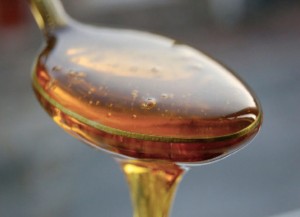Agave Nectar During Pregnancy
 Q Do you have any advice regarding the use of agave nectar during pregnancy? Is it considered safe or it is contraindicated? If contraindicated, do you have any suggestions for an alternate sweetener?
Q Do you have any advice regarding the use of agave nectar during pregnancy? Is it considered safe or it is contraindicated? If contraindicated, do you have any suggestions for an alternate sweetener?
A One of my fellow dietitians asked a similar question to the vegetarian group within the American Dietetics Association. Usually, a question gets about 2-3 responses. This brought on a brouhaha that lasted for days. There were reports stating agave nectar is processed with formaldehyde, especially if it was not organic. Culinary aspects came into play. There were articles about how high fructose corn syrup was not as bad as thought depending on what aspect of it you were measuring. Here’s my take on the agave nectar issue.
I haven’t found any evidence positive or negative connecting pregnancy and agave nectar. I have found evidence of highly refined sugars and products containing a high amount of refined sugars in them being contraindicated, more specifically with long term weight management in children. In addition, studies showed the diet prior to pregnancy positively or negatively affected pregnancy.
Agave processors claim how great it is because it does not slam the bloodstream as much as table sugar. This is due to the fructose/glucose ratio. Anything ending in ose is a sugar. Fructose is the sweetest sugar. When I think of fructose I think of honey. It has a high fructose/glucose ratio. Table sugar has more glucose than fructose. Glucose when eaten, especially glucose eaten with no fiber as in donuts or candy, goes directly to the blood stream and spikes your insulin level. Fructose, instead, goes to the liver. It is turned into glucose there, but doesn’t cause the insulin to spike and drop in the bloodstream. So, it seems like a better idea. But what about that high FRUCTOSE corn syrup thing.
We are all told to fear high fructose corn syrup [HFCS] because of the high fructose level. The Corn Refiners Association has a website which will tell you all about HFCS and how it has been demonized by the press. They explain how table sugar and HFCS have relatively the same fructose/glucose ratio.
Agave nectar has a higher fructose/glucose ratio than HFCS. The Corn Refiners put HFCS around 50-55% fructose to glucose. Agave nectar is around 70-90 fructose to glucose, according to my colleague, Jeff Novick, RD, MS, LDN, FADA. So if eliminating high fructose in foods in your diet is a goal, then agave is out and HFCS is in. So is table sugar.
The bottom line is the amount you eat. The Corn Refiners state that as HFCS consumption has gone up, glucose consumption has come down. Therefore, there has been no increase in sugar intake due to HFCS being in the market place. People have just switched one for the other. Here are two facts for you from their website. 1) “Annual per capita consumption of high fructose corn syrup for 2009 was 35.7 pounds,” 2) “The 2009 sugar consumption estimate was nearly 10 pounds greater at 45.3 pounds per person.” That means the average American was eating around 81 pounds of these sweeteners in 2009. That’s a little over 16 – 5 pound bags of sugar for each one of us. I could build a snow fort with what my family supposedly eats per annum.
When I was pregnant I avoided most sweets. On the other hand, my one craving incident that drove me out of the house and to the corner store was a need for something sweet. I was dreaming of chocolate, but stopped myself and thought, ok girlfriend, what are you really wanting? I knew it was sugar. I bought a quarter of a watermelon and ate it in about 5 minutes. Craving sated.
My advice is stick to the sugars in the original packaging like peels and skins. Leave the paper, plastic and people-packaged items on the shelf.

